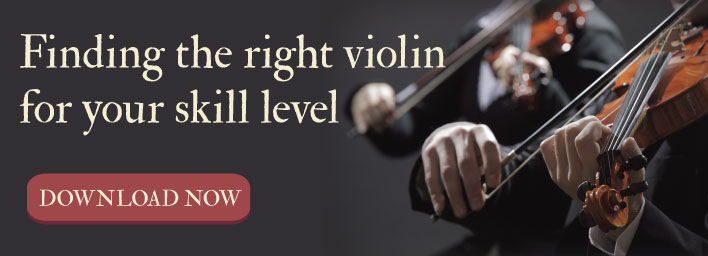How Can I Tell If My Child Is Ready For A Better Violin?

Knowing when to purchase a new instrument can be tricky. And when you consider the cost of a new violin, you want to be sure that your child is ready for the upgrade from a student instrument. Since the United States doesn’t have standardized level of play, such as the ABRSM (an international organization that has standardized violin performance into graded test levels), it can be a little difficult to accurately ascertain when you child is ready for a better quality instrument.
Although many teachers and conservatories endorse the ABRSM system of evaluation, if your child is learning to play the violin with a private instructor or in a school setting that doesn’t measure performance through a standard system, the most important things to consider before upgrading to a better quality instrument involve your child’s performance, ease, and enjoyment. Because no matter what else, making progress and appreciating the journey are the most important factors in learning to play any musical instrument. If children are worrying about reaching the right level at the right time, it can stifle the pleasure and satisfaction of playing their violin.
However, if you’ve purchased a student violin, or have been renting a violin for a few years while your child learns and would like to know if she’s ready for a new instrument, these guidelines can help you make that determination.
Get Disinterested, Professional Advice (another word for disinterested. impartial, or?)
Your child’s teacher, an experienced luthier, or a violinist you know can offer great advice. Since the need for a better quality violin is highly subjective, it will basically come down to whether or not your child’s skill level will be enhanced by an instrument upgrade.
If you do decide to purchase a better quality violin, you’ll be amazed at the difference it can make in the quality of sound produced and how much easier it will be for your child to play. Violins are priced according to certain standards. These include the materials used, the workmanship, the shop that sells it, and where it is made.
Although typically, instruments that are hand-crafted in countries like the U.S., Germany, or some other European nation can be much more expensive than those made in Taiwan or China, there are some stunningly great instruments produced from those Asian countries. The tonal excellence produced by quality manufactured instruments, which are then set-up by an experienced luthier, is exceptionable, and the reasonable price makes these violins a perfect solution for beginners and intermediate students.
Consider Your Child’s Performance and Dedication
Many student violins are initially chosen with one basic goal: getting an instrument that will be cost effective and be easy to play for young learners. But, once your child has progressed far enough in her playing, a better quality instrument can help her achieve greater heights of excellence.
You can look for these signs to know when a better violin would help:
- Frequent tuning is needed to keep the violin in tune (especially during practice sessions)
- Cracks or other structural problems (buzzing) seem recurrent—you’re always taking the instrument into a shop for minor repairs
- Your child has to struggle to produce correct tones—the violin gets harder to play
- Your child has been playing for at least three years and is as enthusiastic (or more so) about it now as he was when he started
A Few Tips
Take your child to your local luthier shop (highlighting not working - also want to be more inclusive of other shops like Band & Orchestra) to try out new instruments. Don’t consider the price (I"m not sure this is best advice to not consider price at all, but i do like exploratory), use the time as an exploratory experience. Have your child play as many instruments as possible to see which ones feel and sound the best. And it can help to take along another set of ears to help you consider the sound differences in the violin your child currently owns and the ones you’re considering.
Remember, the instrument you and your child choose will last for quite a while, so take your time and make sure that the next instrument you buy will offer your child many more years of satisfying play.


